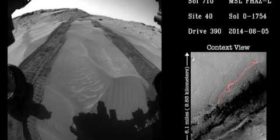NASA is known to make various discoveries, but this is one discovery that happened in the most unlikeliest of places – the deserts of Kazakhstan.
The International Space Station has released satellite images of some 8000-year-old ancient settlements in the desert of Kazakhstan. The photos have sparked new interest in the archaeological sites and could lead to new discoveries regarding the purpose of these prehistoric configurations.
The feat comes in the form of mysterious earthworks on the steppes of Kazakhstan, covering a massive amount of land. The hundreds of mounds, first discovered by a Kazakhstani economist in 2007, are arranged to form distinct shapes.
According to theweathernetwork.com, the largest, which looks like a square with 284 metres sides cut by two diagonal lines 406 metres long, is larger than the area of Egypt’s Great Pyramid of Giza. The Ushtogaysky Square, as it is known, is one of the five geometric shapes detected so far, made up of around 260 identifiable earthworks.
Another structure, a swastika, also called the Turgai swastika, is made up of timber. Swastika is an ancient symbol that is being used in many religions for the thousands of years to depict power and prosperity.
According to the New York Times, these findings suggest that the figures could be associated with the Mahandzhar culture, which existed in the area between 7,000 B.C. and 5,000 B.C. If this is true, it would make the structures the oldest such creations ever found, and force archaeologists to significantly reconsider prevailing theories about ancient nomadic cultures






Leave a reply